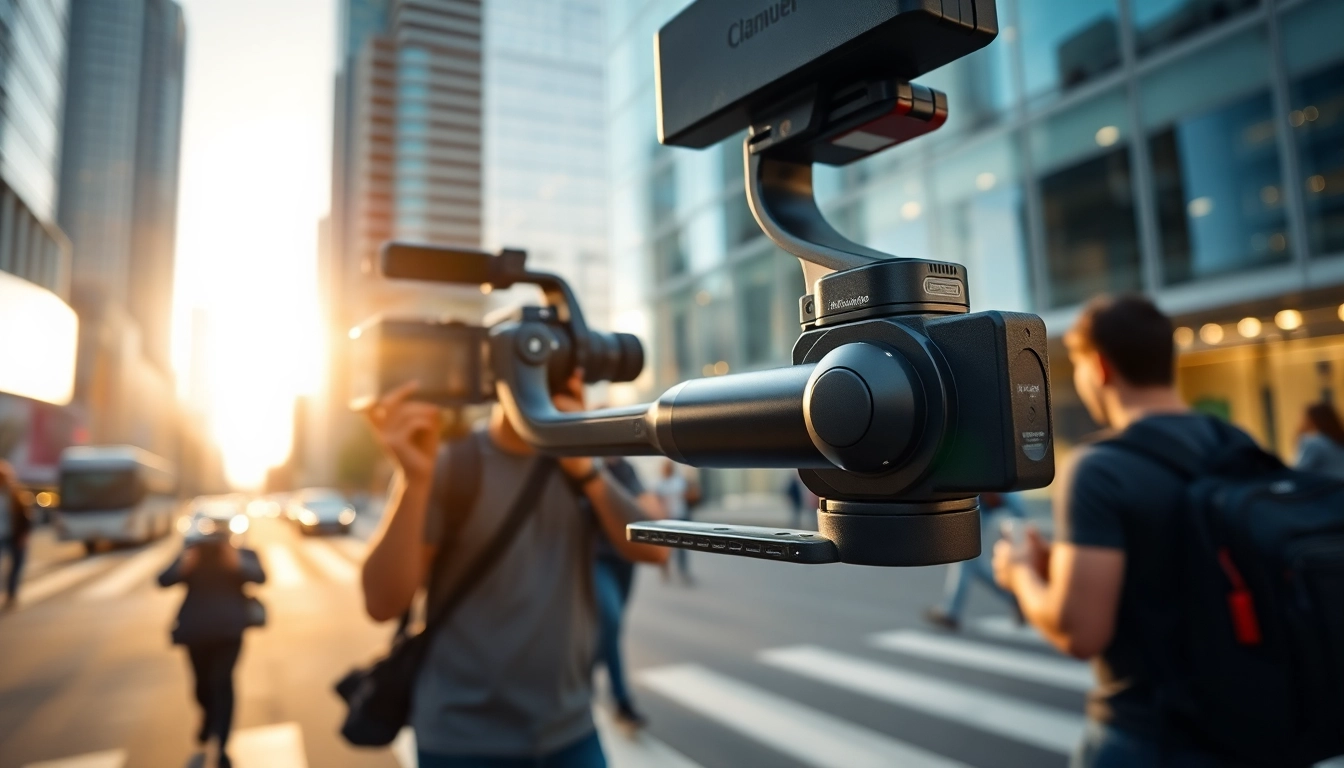Understanding Handheld Gimbal Basics
What is a Handheld Gimbal?
A handheld gimbal is a portable stabilization device designed to eliminate unwanted movements in video footage. Its primary purpose is to create smooth, cinematic results by balancing the camera and compensating for natural hand movement and shakes. Unlike traditional tripods or monopods, which are stationary, a handheld gimbal allows for a wide range of motion, providing versatility for filmmakers and content creators. This adaptability has made the handheld gimbal an essential tool in both amateur and professional videography.
Key Components of Handheld Gimbal Technology
Handheld gimbals consist of several key components:
- Motors: The heart of a gimbal, typically employing brushless motors to align the camera with the correct orientation.
- Control Board: Interprets inputs from the sensors to adjust motor movements, providing real-time stabilization.
- Mounting Plate: The area where the camera or smartphone is secured, often allowing for quick-release or adjustments.
- Handle: Facilitates ease of holding, often ergonomically designed for extended use.
- Battery: Powers the gimbal’s motors and electronic components. Battery longevity is a key factor for extended shoots.
How a Handheld Gimbal Works
A handheld gimbal operates based on a three-axis stabilization system, which maintains the camera’s level regardless of the user’s movement. The three axes include:
- Yaw Axis: Controls horizontal movement (left/right).
- Pitch Axis: Controls vertical tilt (up/down).
- Roll Axis: Stabilizes the camera rotation around the lens direction.
When a user moves or shakes the gimbal, sensors detect the motion. The electronic control board calculates the appropriate adjustments needed for the motors to counteract these movements. This process happens in fractions of a second, resulting in smooth and stable video capture.
Choosing the Right Handheld Gimbal for Your Needs
Factors to Consider When Selecting a Handheld Gimbal
When selecting a handheld gimbal, various factors should be considered to ensure you choose the right one for your needs:
- Camera Compatibility: Make sure the gimbal supports the weight and dimensions of your camera.
- Payload Capacity: Each gimbal has a maximum weight it can support; exceeding this can lead to performance issues.
- Run Time: Consider the battery life if you plan to shoot for extended periods without recharging.
- Features: Assess whether you need additional features like active tracking, built-in timelapse, or motion control.
- Portability: If you plan to travel, look at the gimbal’s weight and size for ease of transport.
Comparing Different Models of Handheld Gimbals
With numerous models available in the market, comparing features and specifications can be crucial. Here are some elements to look for when comparing different models:
- Stabilization Technology: Some gimbals use advanced algorithms for stabilization, offering better performance in dynamic shooting conditions.
- Ease of Use: Consider how intuitive the controls and setup processes are. A user-friendly interface can save time.
- Included Accessories: Some models may come with additional accessories, such as cables for charging, storage cases, or additional mounts.
Budgeting for Your Handheld Gimbal Purchase
Budgeting is an essential step in purchasing a handheld gimbal. Prices can vary significantly depending on the brand, features, and capabilities. Typically, you can find gimbals ranging from low-cost options for beginners to high-end models designed for professional filmmakers. It’s wise to set a budget that allows for not just the purchase of the gimbal but also potential accessories and maintenance.
Techniques for Using a Handheld Gimbal Effectively
Setting Up Your Handheld Gimbal for Optimal Performance
Proper setup is crucial for maximizing the performance of your handheld gimbal. Follow these steps:
- Balance Your Camera: Ensure that your camera is leveled and correctly balanced on the gimbal’s plate. This reduces strain on the motors and enhances stabilization.
- Calibrate the Gimbal: Most gimbals come with a calibration feature. Running this process will help the stabilization system function more effectively.
- Adjust Settings: Depending on your shooting style, you may want to tweak settings such as motor sensitivity and follow modes.
Creatively Capturing Footage with a Handheld Gimbal
Using a handheld gimbal opens up creative possibilities for capturing footage. Here are some techniques:
- Dolly Zoom: Use a combination of moving the gimbal closer to your subject while zooming out to create a dramatic effect.
- Walking Shots: Maintain a steady walking pace while holding the gimbal at waist height, allowing for smooth, flowing shots.
- Panning: Slow, smooth pans can create a cinematic look. Practice maintaining a consistent speed to avoid jarring movements.
Common Mistakes to Avoid with Handheld Gimbals
To make the most out of your handheld gimbal, avoid these common mistakes:
- Neglecting Balance: Failing to balance the camera before use can lead to strained motors and uneven footage.
- Ignoring Battery Life: Always keep an eye on battery levels, especially during long shoots where recharging may not be possible.
- Overcomplicating Moves: Trying to execute complex movements without practice can lead to shaky footage. Start with simple movements.
Advanced Features of Handheld Gimbals
Understanding Smart Functions in Your Handheld Gimbal
Modern handheld gimbals often come equipped with smart functions that enhance usability and functionality. Common features include:
- Active Tracking: Many gimbals are capable of keeping a subject in focus automatically.
- Time-lapse and Hyper-lapse Modes: These modes simplify the setup for capturing sequences over time.
- App Connectivity: Some gimbals allow for smartphone connectivity, enabling remote control and additional features via dedicated apps.
Enhancing Your Shots with Handheld Gimbal Accessories
Accessorizing your handheld gimbal can elevate your shooting experience. Useful accessories to consider include:
- External Microphones: Improve audio quality, particularly for vlogs and interviews.
- Lighting Equipment: Attach small LED lights for better illumination in dim settings, providing a more professional look.
- Smartphone Holders: If you shoot with a smartphone, a dedicated holder can provide better stability and additional controls.
Utilizing Off-Peak Techniques for Smoothness
To achieve smoother footage even in challenging conditions, consider these off-peak techniques:
- Posture Adjustment: Maintain an athletic posture when operating the gimbal; flexibility in your knees can absorb shocks from uneven terrain.
- Slow Motions: Filming at higher frame rates can create smooth slow-motion shots, adding a dramatic effect to your footage.
- Use of Legs or Anchor Points: When filming static subjects, anchoring the gimbal to a stable surface or incorporating your body as a stabilizing point can further reduce shake.
Maintaining and Troubleshooting Your Handheld Gimbal
Regular Maintenance for Your Handheld Gimbal
To ensure longevity and consistent performance from your handheld gimbal, regular maintenance is vital. Consider the following maintenance tips:
- Regularly Check Screws and Bolts: Periodically inspect and tighten any loose screws or bolts to maintain stability.
- Keeping it Clean: Use a microfiber cloth to keep the gimbal free from dust and debris, particularly around motors and sensors.
- Battery Care: Follow proper charging guidelines, and store the gimbal with a charged battery to prolong its lifespan.
Troubleshooting Common Handheld Gimbal Issues
Even with proper use and maintenance, you may encounter issues with your handheld gimbal. Here are some common problems and solutions:
- Camera Shaking: This can indicate a lack of balance or low battery. Rebalance the camera and check battery levels.
- Overheating: If the gimbal is overheating, allow it to cool down and ensure it’s not working continuously without breaks.
- Software Glitches: If the gimbal is behaving erratically, consider resetting the gimbal or checking for firmware updates.
Upgrading Your Gimbal: When and How
Deciding to upgrade your handheld gimbal can enhance your shooting capabilities significantly. Consider upgrading when:
- Your current gimbal does not meet your evolving filming needs.
- It is unable to support new camera models or accessories.
- The technology in the newer models provides significant benefits, like improved battery life or advanced features.
When upgrading, research thoroughly to match a gimbal that suits your specific usage scenarios and budget.



